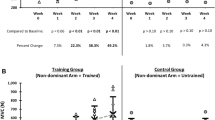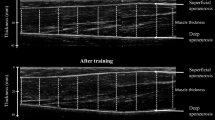Summary
The central changes associated with a period of strength training have been investigated in a group of 32 young healthy volunteers. Subjects participated in one of three 12 week training programmes, which required different degrees of skill and coordination. Study 1 consisted of unilateral isometric training of the quadriceps with the contralateral leg acting as a control, the apparatus providing firm back support and a lap strap. In Study 2 training consisted of unilateral concentric leg-extension with back support and hand-grips. In Study 3 subjects performed bilateral leg-extension with no back support. Measurements of maximum voluntary isometric strength were made at 2–3 week intervals and a continual record was kept of the weights lifted in Studies 2 and 3. The largest increase in isometric force was seen for the trained leg in Study 1 (approximately 40%). There was no significant change in strength in the contralateral untrained leg. In Studies 2 and 3 there was a large increase in training weights (about 200%) associated with smaller increase in isometric force (15–20%). It is concluded that a large part of the improvement in the ability to lift weights was due to an increased ability to coordinate other muscle groups involved in the movement such as those used to stabilise the body. The importance of these findings for athletic training and rehabilitation is discussed.
Similar content being viewed by others
References
Belanger AY, McComas AJ (1981) Extent of motor-unit activation during effort. J Appl Physiol 51:1131–1135
Chapman SJ, Edwards RHT, Greig C, Rutherford O (1984) Practical application of the twitch interpolation technique for the study of voluntary contraction of the quadriceps muscle in man. J Physiol 353:3 P
Edwards RHT, Young A, Hosking GP, Jones DA (1977) Human skeletal muscle function: description of tests and normal values. Cli Sci Mol Med 52:283–290
HÄkkinen K, Komi PV (1983) Electromyographic changes during strength training and detraining. Med Sci Sports Exerc 15:455–460
Hellebrandt FA, Houtz SJ (1956) Mechanisms of muscle training in man: experimental demonstration of the overload principle. Phys Ther Rev 36:371–383
Ikai M, Fukunaga T (1970) A study on training effect on strength per unit cross-sectional area of muscle by means of ultrasonic measurement. Int Z Angew Physiol 28:173–180
Komi PV, Buskirk ER (1972) Effect of eccentric and concentric muscle conditioning on tension and electrical activity of human muscle. Ergonomics 15:417–434
Moritani T, De Vries HA (1979) Neural factors versus hypertrophy in the time course of muscle strength gain. Am J Phys Med 58:115–130
Rasch PJ, Morehouse LE (1957) Effect of static and dynamic exercises in muscular strength and hypertrophy. J Appl Physiol 11:29–34
Sale D, MacDougall D (1981) Specificity in strength training: a review for the coach and athlete. Sports W-4
Thorstensson A, Karlsson J, Viitasalo JHT, Luhtanen P, Komi PV (1976) Effect of strength training on EMG of human skeletal muscle. Acta Physiol Scand 98:232–236
Young A, Stokes M, Round JM, Edwards RHT (1983) The effect of high resistance training on the strength and cross-sectional area of the human quadriceps. Eur J Clin Invest 13:411–417
Author information
Authors and Affiliations
Rights and permissions
About this article
Cite this article
Rutherford, O.M., Jones, D.A. The role of learning and coordination in strength training. Europ. J. Appl. Physiol. 55, 100–105 (1986). https://doi.org/10.1007/BF00422902
Accepted:
Issue Date:
DOI: https://doi.org/10.1007/BF00422902




